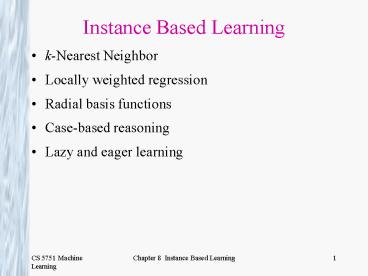Instance Based Learning PowerPoint PPT Presentation
Title: Instance Based Learning
1
Instance Based Learning
- k-Nearest Neighbor
- Locally weighted regression
- Radial basis functions
- Case-based reasoning
- Lazy and eager learning
2
Instance-Based Learning
3
When to Consider Nearest Neighbor
- Instance map to points in Rn
- Less than 20 attributes per instance
- Lots of training data
- Advantages
- Training is very fast
- Learn complex target functions
- Do not lose information
- Disadvantages
- Slow at query time
- Easily fooled by irrelevant attributes
4
k-NN Classification
5
Behavior in the Limit
- Define p(x) as probability that instance x will
be labeled 1 (positive) versus 0 (negative) - Nearest Neighbor
- As number of training examples approaches
infinity, approaches Gibbs Algorithm - Gibbs with probability p(x) predict 1, else
0 - k-Nearest Neighbor
- As number of training examples approaches
infinity and k gets large, approaches Bayes
optimal - Bayes optimal if p(x) gt 0.5 then predict 1,
else 0 - Note Gibbs has at most twice the expected error
of Bayes optimal
6
Distance-Weighted k-NN
7
Curse of Dimensionality
- Imagine instances described by 20 attributes, but
only 2 are relevant to target function - Curse of dimensionality nearest neighbor is
easily misled when high-dimensional X - One approach
- Stretch jth axis by weight zj, where z1,z2,,zn
chosen to minimize prediction error - Use cross-validation to automatically choose
weights z1,z2,,zn - Note setting zj to zero eliminates dimension j
altogether - see (Moore and Lee, 1994)
8
Locally Weighted Regression
9
Radial Basis Function Networks
- Global approximation to target function, in terms
of linear combination of local approximations - Used, for example, in image classification
- A different kind of neural network
- Closely related to distance-weighted regression,
but eager instead of lazy
10
Radial Basis Function Networks
11
Training RBF Networks
- Q1 What xu to use for kernel function
Ku(d(xu,x))? - Scatter uniformly through instance space
- Or use training instances (reflects instance
distribution) - Q2 How to train weights (assume here Gaussian
Ku)? - First choose variance (and perhaps mean) for each
Ku - e.g., use EM
- Then hold Ku fixed, and train linear output layer
- efficient methods to fit linear function
12
Case-Based Reasoning
- Can apply instance-based learning even when X Rn
- ? need different distance metric
- Case-Based Reasoning is instance-based learning
applied to instances with symbolic logic
descriptions - ((user-complaint error53-on-shutdown)
- (cpu-model PowerPC)
- (operating-system Windows)
- (network-connection PCIA)
- (memory 48meg)
- (installed-applications Excel Netscape
VirusScan) - (disk 1Gig)
- (likely-cause ???))
13
Case-Based Reasoning in CADET
- CADET 75 stored examples of mechanical devices
- each training example
- ltqualitative function, mechanical structuregt
- new query desired function
- target value mechanical structure for this
function - Distance metric match qualitative function
descriptions
14
Case-Based Reasoning in CADET
15
Case-Based Reasoning in CADET
- Instances represented by rich structural
descriptions - Multiple cases retrieved (and combined) to form
solution to new problem - Tight coupling between case retrieval and problem
solving - Bottom line
- Simple matching of cases useful for tasks such as
answering help-desk queries - Area of ongoing research
16
Lazy and Eager Learning
- Lazy wait for query before generalizing
- k-Nearest Neighbor, Case-Based Reasoning
- Eager generalize before seeing query
- Radial basis function networks, ID3,
Backpropagation, etc. - Does it matter?
- Eager learner must create global approximation
- Lazy learner can create many local approximations
- If they use same H, lazy can represent more
complex functions (e.g., consider Hlinear
functions)
17
kd-trees (Moore)
- Eager version of k-Nearest Neighbor
- Idea decrease time to find neighbors
- train by constructing a lookup (kd) tree
- recursively subdivide space
- ignore class of points
- lots of possible mechanisms grid, maximum
variance, etc. - when looking for nearest neighbor search tree
- nearest neighbor can be found in log(n) steps
- k nearest neighbors can be found by generalizing
process (still in log(n) steps if k is constant) - Slower training but faster classification
18
kd Tree
19
Instance Based Learning Summary
- Lazy versus Eager learning
- lazy - work done at testing time
- eager -work done at training time
- instance based sometimes lazy
- k-Nearest Neighbor (k-nn) lazy
- classify based on k nearest neighbors
- key determining neighbors
- variations
- distance weighted combination
- locally weighted regression
- limitation curse of dimensionality
- stretching dimensions
20
Instance Based Learning Summary
- k-d trees (eager version of k-nn)
- structure built at train time to quickly find
neighbors - Radial Basis Function (RBF) networks (eager)
- units active in region (sphere) of space
- key picking/training kernel functions
- Case-Based Reasoning (CBR) generally lazy
- nearest neighbor when no continuos features
- may have other types of features
- structural (graphs in CADET)

